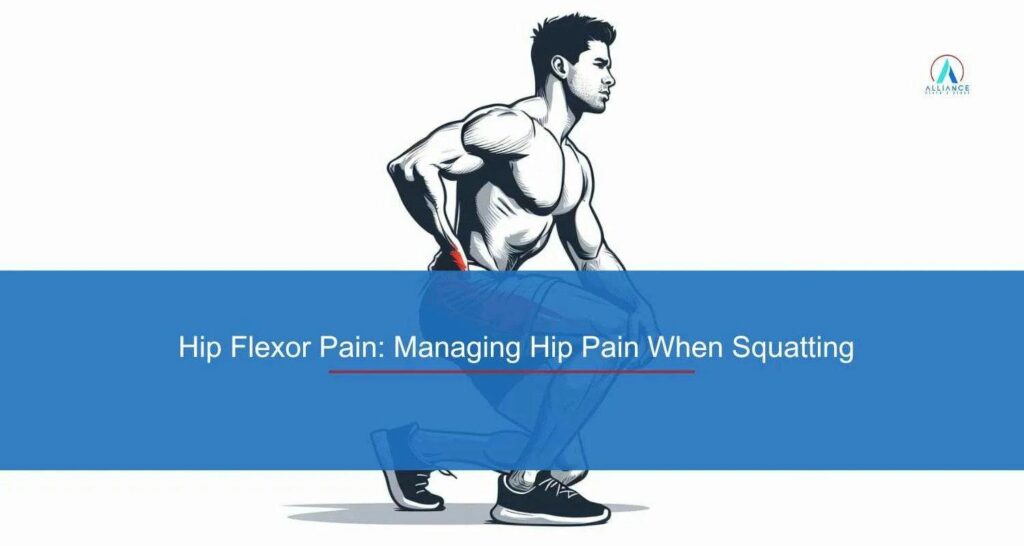Introduction
Squatting is an essential exercise in many fitness routines, but it can sometimes lead to discomfort in the hip region. Hip pain when squatting is a common issue that can hinder your workout progress.
In this article, we will delve into the causes, symptoms, diagnosis, treatment, and prevention of hip flexor pain, empowering you to continue squatting pain-free.
What is Hip Flexor Pain?
Hip flexor pain refers to discomfort or aching in the front of the hip and groin area. This condition can range from mild discomfort to severe pain, and it often happens when performing daily activities that involve hip flexion, such as squatting. The hip flexors are a group of muscles that play a crucial role in lifting your thigh toward your torso, and when they become strained or injured, it leads to hip flexor pain.
Why does it occur when squatting?
Hip flexor pain squatting commonly occurs during squats due to the intense demand on these muscles. Squatting requires hip flexors to contract and stabilize the pelvis. When done improperly or excessively, it can lead to strain and pain.
Who is most at risk?
Individuals who frequently perform squats, especially weightlifters and athletes, are at a higher risk of experiencing hip flexor pain. Additionally, those with weak hip abductor muscles or a history of hip injuries may be more susceptible.
Anatomy and Function of the Hip Flexors

To fully grasp the complexities of hip pain when squatting, it’s essential to have a deeper understanding of the anatomy and function of the hip flexors. These crucial muscles form a group that is pivotal in your entire body’s ability to lift your knees and flex at the waist.
The hip flexors are comprised of various muscle groups, with the most prominent ones being the iliopsoas, rectus femoris, and sartorius muscles. These muscles work harmoniously to facilitate movements that involve raising your legs and bending at the waist, making them indispensable for activities like squatting.
Understanding hip structure and function is fundamental to addressing and preventing hip pain from squats.
Causes of Hip Flexor Pain When Squatting
To effectively manage hip flexor pain, it’s vital to identify its root causes. Several factors can contribute to hip flexor pain during squats:
Tight Hip Flexors
When your hip flexor muscles are tight, they become less flexible and more prone to strain during squats. Fitness professionals often express concern about tight muscles of the lower extremities, as it can be associated with various hip conditions such as hip impingement or femoroacetabular impingement.
Weak Hip Flexors
Weak hip flexors can’t adequately support the demands of squatting, leading to overcompensation by other core muscles and eventual pain.
Muscle Imbalances
Imbalances between the hip flexor and opposing muscle groups can lead to improper movement patterns during squats, causing discomfort.
Overtraining
Excessive squatting without proper rest and recovery can overwork the hip flexors, resulting in pain.
Injuries
A history of hip injuries, such as strains, tears, or hip pinching, can make hip flexors more susceptible to pain in the hip during squats.
Symptoms of Hip Flexor Pain When Squatting

Recognizing the symptoms of hip flexor pain is crucial for early intervention. Common signs include:
- Aching or sharp pain in the front of the hip or groin area.
- Discomfort that worsens with squatting or hip-related movements.
- Tenderness to touch in the hip flexor region.
- Limited range of motion and difficulty raising the knee.
If you suspect hip flexor pain, consult a healthcare professional for a thorough evaluation.
Diagnosis of Hip Flexor Pain When Squatting
Diagnosing hip flexor pain when squatting is a crucial step in understanding the underlying causes and determining the most appropriate treatment. Healthcare professionals employ a combination of methods to accurately diagnose this condition.
Here’s an explanation of the diagnosis process:
- Physical Examination: A healthcare professional will assess the range of motion, muscle strength, and tenderness in the hip and groin area to identify any signs of hip flexor pain. This physical assessment allows them to identify any noticeable symptoms of hip flexor pain, such as discomfort or limited hip mobility during specific movements.
- Medical History Evaluation: Understanding your medical history is essential for a comprehensive diagnosis. Your healthcare provider will inquire about your prior injuries, exercise routines, and any past instances of hip or lower back pain.
- Imaging Tests: In some cases, healthcare professionals may recommend imaging tests like X-rays or MRI (Magnetic Resonance Imaging) to obtain a more detailed view of the affected area. These imaging techniques can help rule out other potential issues, such as fractures, joint problems, or soft tissue injuries. X-rays are useful for detecting bone-related problems, while MRI scans provide a clearer picture of soft tissues like hip muscles and tendons.
- Ultrasound: Ultrasound is another imaging tool that can be used to assess the hip flexors. It allows for real-time visualization of the affected area, making it a valuable diagnostic method for identifying muscle strains and inflammation.
- Blood Tests: In certain cases, blood tests may be recommended to rule out underlying medical conditions that could contribute to hip flexor pain. These tests help determine if systemic factors or infections are causing the discomfort.
- Provocative Tests: Healthcare professionals might also perform specific provocative tests to reproduce the pain you’re experiencing. These tests can help confirm that the hip flexors are the source of the discomfort.
Treatment of Hip Flexor Pain When Squatting

The good news is that hip flexor pain can often be managed with conservative treatments, including:
- Rest and temporarily avoid squats: Give your hip flexors time to heal by avoiding activities that make the pain worse, including deep squats.
- Ice and heat therapy: Applying ice can reduce inflammation, while heat can help relax the hip muscles.
- Proper Form: Ensure your squat position is correct, as this will minimize strain on the hip flexors. Maintaining a neutral position and proper core stability is a fundamental aspect of proper squatting technique.
- Physical therapy: A physical therapist can guide you through exercises to strengthen and stretch the hip flexors.
- Anti-inflammatory medications: Over-the-counter medications can help manage pain and inflammation if recommended by a healthcare provider.
Ways to Prevent Hip Flexor Pain When Squatting
Prevention is always better than cure. To reduce the risk of hip flexor pain during squats, consider the following tips:
- Ensure proper squat stance and technique.
- Perform corrective exercises that improve the strength of your hip abductor muscles and proper core stability.
- Gradually increase the intensity and volume of squats.
- Incorporate hip flexor-specific stretches into your warm-up routine.
- Balance your workout routine to avoid overtraining.
- Listen to your body and give it adequate time to recover.
Consult Alliance Regen and Rehab
If you’re struggling with hip flexor pain and need professional guidance, consider reaching out to Alliance Regen and Rehab. Their experienced team can provide expert advice and personalized solutions to help you overcome hip flexor pain and improve hip function.
Conclusion
Understanding and managing hip flexor pain when squatting is crucial for any fitness enthusiast. By recognizing the causes, symptoms, and treatment options, you can continue to enjoy the benefits of squats without unnecessary discomfort. Remember to prioritize your health and well-being while pursuing your fitness goals.
FAQs
What is the most common hip flexor pain?
The most common hip flexor pain is a result of overuse or strain, often caused by activities like squatting.
How do I know if my hip pain is serious?
If your hip pain after squats is severe, persistent, or accompanied by other concerning symptoms, it’s essential to consult a healthcare professional for a proper evaluation and diagnosis.
How do I know if my hip is damaged?
Severe pain, swelling, lack of mobility, and hip pinching in the hip region can be indicators of potential hip damage. Consulting a health professional is advisable to assess the extent of the damage and explore appropriate treatment options.



My brother recommended I might like this blog.
He was entirely right. This post actually made my day.
You cann’t imagine simply how much time I had spent for
this information! Thanks!